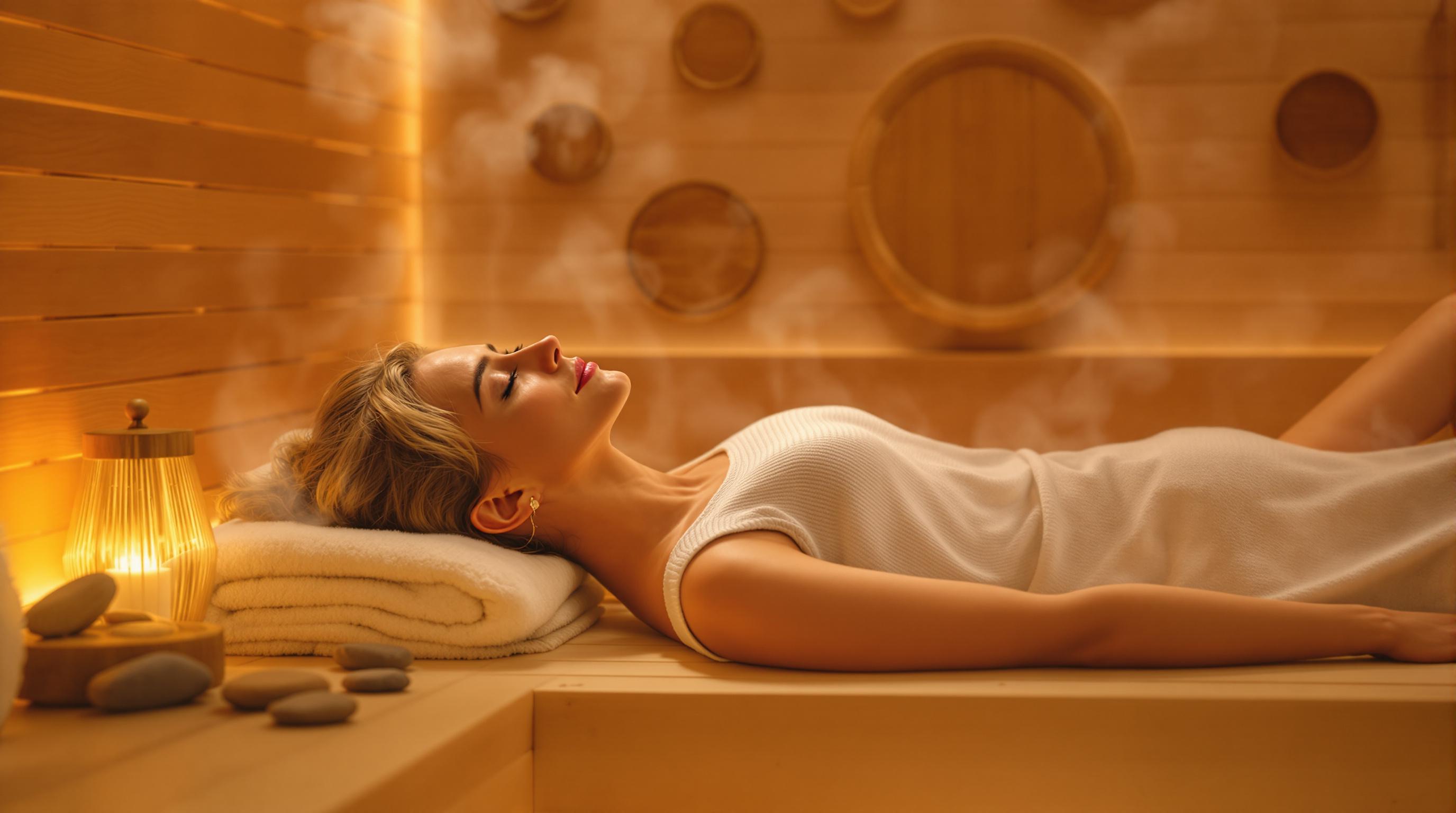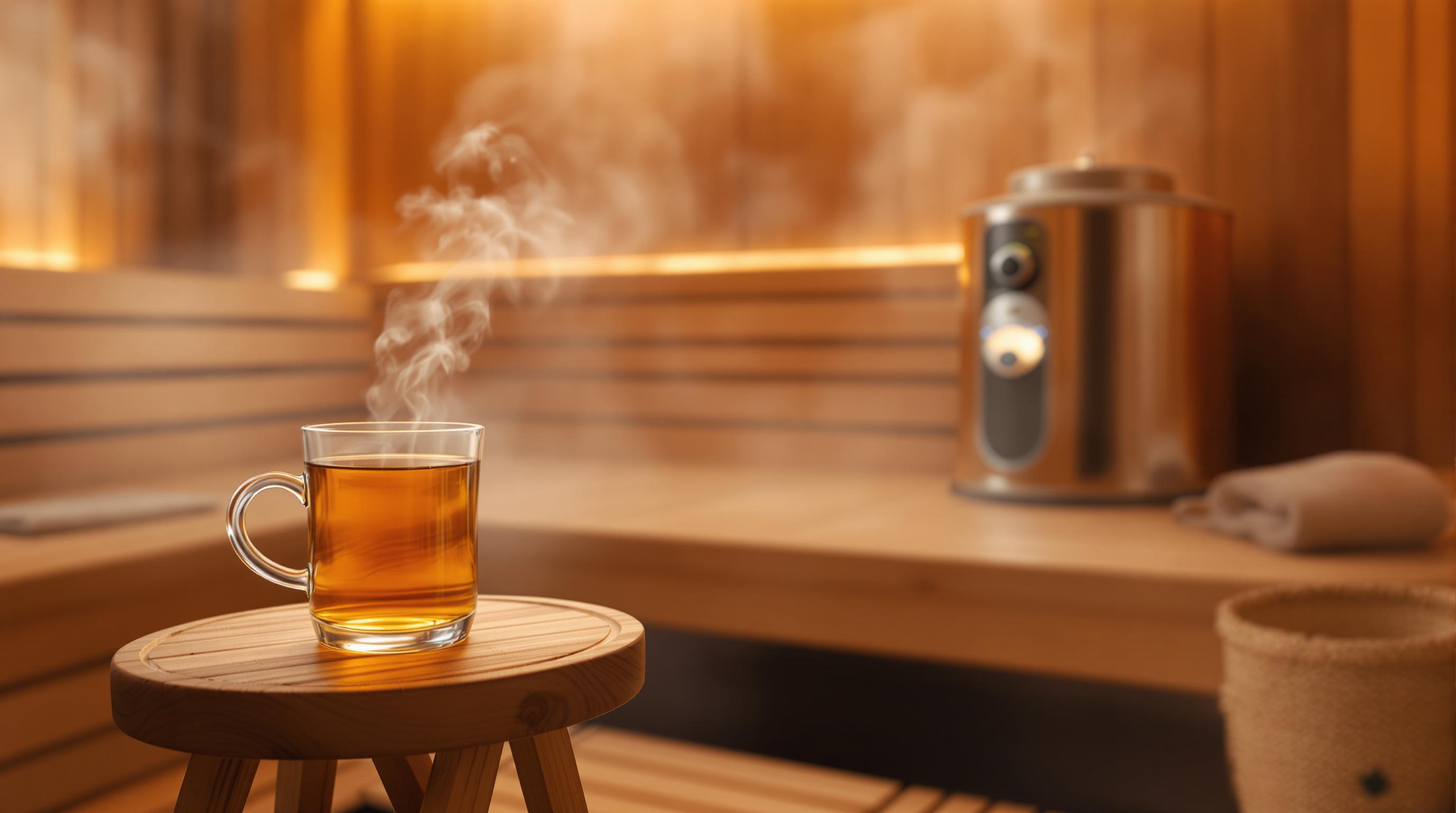Mold in saunas grows due to high humidity, poor airflow, and lack of maintenance. It thrives on wood and in damp, hard-to-reach areas like corners and under benches. Mold not only damages your sauna but can also cause respiratory issues, skin irritation, and allergic reactions. Here’s how to prevent it:
- Control Humidity: Keep levels between 10-20%; use a hygrometer to monitor.
- Improve Ventilation: Ensure proper airflow with intake and exhaust vents; leave the door open for 30 minutes after use.
- Regular Cleaning: Wipe surfaces after each session and deep clean weekly with mild cleaners like tea tree oil or Murphy Oil Soap.
- Choose Mold-Resistant Materials: Use cedar wood and avoid sealing or painting surfaces.
- Inspect Frequently: Check corners, under benches, and vents for mold or musty smells.
If you already have mold, clean small areas with tea tree oil or bleach solutions. For larger infestations, call professionals. Prevention is key - consistent airflow, cleaning, and moisture control will keep your sauna mold-free.
Why Mold Grows in Saunas
Understanding what causes mold in saunas is key to stopping it before it becomes a problem. There are three main factors that make saunas a prime spot for mold growth.
Moisture and Humidity
Saunas are filled with steam, sweat, and high humidity, all of which create constant moisture - perfect conditions for mold. When temperatures shift, condensation forms on cooler surfaces like walls and benches, especially in outdoor saunas [1][3]. This moisture builds up over time, giving mold the ideal environment to grow.
Lack of Air Flow
Poor ventilation is another big reason mold thrives in saunas. Without proper airflow, humid air gets trapped, creating still, damp areas where mold can easily take hold. Good air circulation is essential for keeping humidity in check and stopping mold from forming.
| Location | Air Flow Issue | Result |
|---|---|---|
| Corners | Limited air movement | Moisture builds up |
| Under benches | Restricted circulation | Dampness lingers |
| Behind heaters | Dead air spaces | Constant humidity |
Poor Maintenance
Skipping regular upkeep is a recipe for mold trouble. Cleaning isn't just about keeping things tidy - it’s a must for keeping mold at bay. Common mistakes include:
- Forgetting to clean and dry surfaces after use
- Using cleaning products that leave behind moisture [1][3]
Mold can start growing in as little as 24-48 hours under the right conditions. Choosing materials like cedar wood, which naturally resists fungi, can help reduce the risk [6][2]. Spotting mold early and addressing maintenance gaps can save you from bigger problems down the line.
Signs of Mold in Your Sauna
Mold thrives in places with excess moisture, limited airflow, and inadequate upkeep. These conditions can make your sauna a prime spot for mold growth.
Spotting Mold Growth
Mold usually appears as dark stains or patches on wood and other surfaces, especially in areas with poor ventilation. Keep an eye on these high-risk spots:
| Location | Visual Signs | Risk Level |
|---|---|---|
| Corners, crevices, and under benches | Dark spots, discoloration | Very High |
| Near heater | Fuzzy growth, staining | Medium |
| Floor and lower walls | Spotting, dark patches | High |
Mold Smells
A damp, earthy odor is often the first clue that mold might be present, even before you see it. This smell is most noticeable when opening the sauna door or in poorly ventilated areas like corners or around wooden accessories [1][3].
Physical Reactions
Physical symptoms can also hint at mold issues. Here are some common reactions to watch out for:
| Symptom | When to Take Action |
|---|---|
| Respiratory issues | Seek immediate inspection |
| Skin irritation | Inspect within 24-48 hours |
| Additional allergic reactions | Investigate promptly based on severity |
These symptoms often worsen during or right after sauna use. People with pre-existing health conditions might experience stronger reactions, making regular sauna checks even more important.
To stay ahead of mold, consider using a hygrometer to track humidity levels. Mold is more likely to grow when humidity stays above 60%. Regularly inspect hard-to-reach areas in your sauna to catch potential problems early [3][7].
Spotting these signs promptly is key, but taking steps to stop mold from forming in the first place is even more important.
How to Prevent Sauna Mold
Improving Airflow
Good airflow is key to keeping mold out of your sauna. To achieve this, make sure your sauna has properly placed vents. Here's a quick breakdown:
| Ventilation Component | Purpose | Maintenance Frequency |
|---|---|---|
| Floor-level intake vent | Brings in fresh air | Check monthly for blockages |
| Ceiling exhaust vent | Removes humid air | Clean every 3 months |
| Door vent or gap | Promotes circulation | Inspect weekly |
If you have an outdoor sauna, adding extra vents or even small fans can help improve airflow [3]. After each session, leave the sauna door open for at least 30 minutes to let it dry completely [1]. This step is just as important as proper vent placement.
While airflow helps reduce moisture, regular cleaning is your best defense against mold.
Cleaning Routine
Stick to this cleaning schedule to keep your sauna mold-free:
| Timing | Task | Products to Use |
|---|---|---|
| After each use | Wipe down all surfaces | Soft-bristled brush, warm water |
| Weekly | Deep clean benches and floors | Murphy Oil Soap |
| Monthly | Inspect and clean vents | Mild wood cleaner |
| Quarterly | Deep clean all surfaces | Tea tree oil diluted in water |
Using a humidity sensor is a smart way to keep moisture levels under 60%, which makes it harder for mold to grow [5]. Don’t overlook corners and other hard-to-reach spots during your cleaning sessions [1].
But cleaning alone isn’t enough - your choice of materials also plays a big role.
Choosing Mold-Resistant Materials
The materials you use in your sauna can make a huge difference in mold prevention. Cedar wood, for example, is a great option because it naturally resists mold and moisture [3].
What to avoid?
- Sealing interior wood, using non-breathable materials, or installing absorbent flooring - these can trap moisture and encourage mold growth.
For existing saunas, treat high-risk areas with antimicrobial solutions like tea tree oil or vinegar. Just make sure the wood can still "breathe" after treatment [1]. Also, having a proper drainage system in place will help control moisture effectively [4].
sbb-itb-3953eb0
Getting Rid of Sauna Mold
Home Cleaning Methods
For smaller mold problems, try using Murphy Oil Soap or a natural solution like tea tree oil mixed with water at a 1:20 ratio. For tougher mold spots, a bleach and water mix (1:10 ratio) can be effective. Always test any cleaning solution on a hidden area first to ensure it doesn’t damage the wood. When scrubbing, use a soft brush and follow the direction of the wood grain [1][2].
| Cleaning Solution | Mixing Ratio | Ideal For |
|---|---|---|
| Bleach + Water | 1:10 ratio | Surface mold |
| Tea Tree Oil + Water | 1:20 ratio | Natural cleaning |
If the mold doesn’t go away or covers a large area, it’s time to call in the professionals.
Professional Mold Removal
You’ll need professional help if the mold covers more than 10 square feet, has penetrated deep into the wood, keeps coming back after cleaning, or has caused structural damage. Professional services typically cost between $500 and $2,000, but they can save you from more expensive repairs and potential health risks [4]. Once the mold is gone, staying on top of maintenance is key to keeping it from returning.
Stop Mold from Coming Back
Preventing mold from returning requires consistent upkeep. Keep the humidity in your sauna below 60% by using a humidity monitor. Inspect high-risk areas - like corners, vents, and under benches - on a weekly basis [5]. Proper ventilation and regular cleaning are also essential [3].
Here are some tips for ongoing maintenance:
- Wipe down all surfaces after each use.
- Monitor humidity levels regularly.
- Check ventilation systems weekly.
- Address moisture issues as soon as they arise.
- Inspect problem areas frequently.
Find the Home Sauna of Your Dreams

Thinking about upgrading or replacing your sauna? Choosing a model with mold-prevention features can make maintenance much easier. Many modern saunas now include technology designed to keep mold at bay.
Key Mold Prevention Features to Consider
| Feature | Benefit | How It Helps Prevent Mold |
|---|---|---|
| Advanced Ventilation | Improves airflow circulation | Cuts moisture levels by up to 70% |
| Cedar Construction | Naturally resists mold | Antimicrobial properties stop mold growth |
| Removable Benches/Floors | Easier to clean hard-to-reach spots | Keeps hidden areas mold-free |
| Humidity Monitoring | Tracks moisture in real time | Keeps humidity below 60%, ideal for mold prevention |
Smart Design for Better Airflow
Modern saunas often include strategically placed vents to boost airflow and reduce moisture buildup. By positioning vents at different heights, these designs help dry the interior quickly after each use.
Choosing the Right Materials
Cedar wood is a popular choice in modern saunas because it naturally resists mold. Some manufacturers also mix traditional wood with composite materials that are moisture-resistant, giving you added durability and protection.
Maintenance-Friendly Features
When shopping for a sauna, keep an eye out for these helpful features:
- Removable parts like benches and flooring for easier cleaning
- Built-in drainage systems to remove excess water
- Digital humidity monitors to keep moisture levels in check
As you browse options on TopHomeSauna.com, focus on models with these mold-prevention features. They’ll help you maintain a cleaner, healthier sauna with less effort.
Summary: Keeping Your Sauna Mold-Free
To keep your sauna free of mold, focus on proper ventilation, regular cleaning, and smart maintenance. These simple yet effective steps can make a big difference in preventing mold growth.
Key Prevention Tips
| Area of Focus | Action Steps | Why It Works |
|---|---|---|
| Ventilation | Keep the door open for 30 minutes after use | Helps remove up to 70% of moisture |
| Cleaning | Wipe surfaces after every session | Prevents sweat and dirt buildup |
| Humidity Levels | Keep between 10-20% | Makes it harder for mold to grow |
| Material Care | Avoid sealing or painting wood | Lets the wood regulate moisture naturally |
Incorporating these habits into your routine will help stop mold before it starts.
Daily Maintenance and Moisture Control
Daily care is straightforward but essential. After each session, wipe down surfaces with warm water and a soft-bristled brush [1]. Use a hygrometer to check humidity, keeping it within the 10-20% range [4]. To manage moisture effectively:
- Open vents during and after use.
- Run exhaust fans if your sauna has them.
- Use a dehumidifier when needed.
Also, make sure your sauna has a proper drainage system to prevent standing water, and fix any leaks as soon as they appear. Regularly inspect hidden areas like corners and seams to catch any mold early. Consistent ventilation is key to keeping your sauna mold-free over time.
Signs to Watch For
Be alert for musty smells or black spots - these are early signs of mold [1]. If you notice respiratory issues while using the sauna, check for hidden mold right away [3]. By sticking to these practices, you can enjoy a clean, healthy sauna experience.
FAQs
How can you tell if your sauna has mold?
Look for black spots, a musty smell, or unexpected allergic reactions. Mold often hides in places like under benches or behind heaters, where moisture tends to build up [1] [3].
Is mold in a sauna harmful?
Yes, mold in saunas can lead to health problems like respiratory issues, skin irritation, and eye discomfort. Infants and people with weakened immune systems are particularly vulnerable.
| Health Issue | Common Symptoms |
|---|---|
| Breathing | Allergic cough, lung irritation |
| Skin | Eczema flare-ups |
| Eyes | Redness, irritation |
What does mold in a sauna look like?
Mold usually begins as light discoloration in damp, poorly ventilated areas. Over time, it darkens and spreads, showing up as dark green, black, or brown spots. It can appear fuzzy or slimy when active [1]. These areas are often places with constant moisture or limited airflow.


